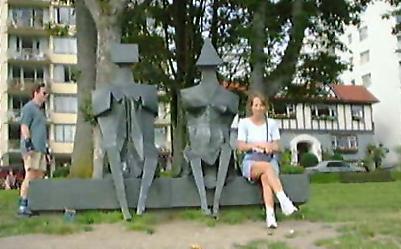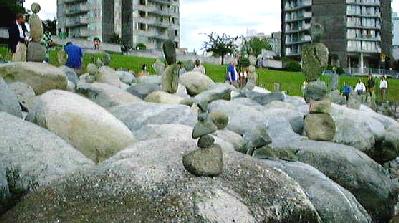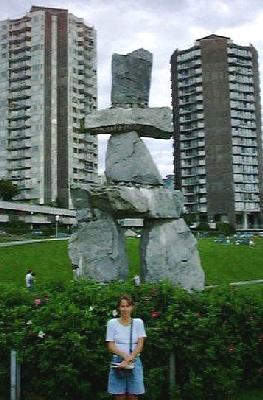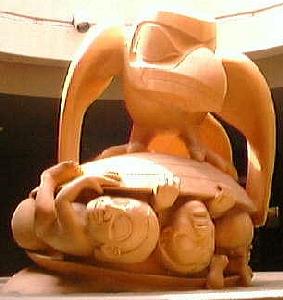
Vancouver
Part one - sculpture

Veronika meets the locals in Vancouver
Monday 5th July - Monday 12th July 1999
On Monday, we caught the early bus from Penticton to Vancouver. The bus first stopped at Rock Creek, and we almost had a disaster there. If you catch a Greyhound bus which requires a transfer, in most cases the company will arrange for your luggage to be automatically transferred from bus to bus. At Rock Creek, the driver assured us that our luggage had been transferred, although being stroppy I insisted on checking, as I hadn't seen Veronika's rucksack being moved. Sure enough, her backpack was still on the first bus, as the person loading the luggage in Penticton had placed it in the wrong compartment. It's just as well that I did check!
One day Veronika and I went for a long walk along the shoreline. We were both excited at being on the west coast, since neither of us had ever been on the Pacific Ocean before. North from the Burrard Bridge, the foreshore is maintained as a trail, with paths and gentle grassy slopes leading down to the sandy beaches which dot the coastline. Given that Vancouver is notorious (within Canada at least) for its grey and rainy weather, we were very fortunate during our stay there: apart from one wet day, we had blue skies and hot sunshine all the time.

Vancouver standing stones
On the shore on English Bay, we came across what was evidently a Vancouver tradition - a number of people were taking rocks from the beach, and attempting to stand them on top of each other in precarious balance. Intrigued, naturally Veronika and I attempted to do the same, although it is not as easy as it may appear. In the picture above, my effort consists of the five stones piled up in the foreground. One guy there was obviously something of an expert, as he was able, with a great deal of patience, to stack rocks up in piles which appeared inherently unstable but were actually fairly secure. This tradition, as with many in the area, would appear to have derived from a First Nations (the Canadian version of the term "Native Americans") tradition. In fact, further along the shore we came across a modern rendition of a Salish sculpture:

A modern Salish statue on English Bay Beach
The figure above is supposed to represent a man with arms outstretched in welcome.
In common with many cities in North America, Vancouver has a strong tradition of outdoor sculpture. The city also appears to take great pride in combining Western and native styles and motifs to create something which is altogether new. In particular, during our visit to the University of British Columbia's Museum of Anthropology, I was particularly taken by a statue by Bill Reid, a native artist, entitled The Raven and the First Men. Carved from 47 trunks of cedar, the sculpture represents a local creation legend. After the great flood (a story which is evidently present in the traditions of most cultures around the world, and is so widespread as to suggest that there must be at least some truth in it), the raven was flying around the newly revealed land looking for something interesting in the monotonous landscape. Eventually he saw something half buried under the sand. Clearing the sand away revealed a giant clam shell from which noises were emerging. The raven pulled open the shell to reveal little creatures trying to escape. These were the first men, ancestors of the Musqueam, a Salish band native to British Columbia.

Bill Reid's "The Raven and the First Men" at the UBC Museum of Anthropology
Also at the Museum of Anthropology was the oldest sculpture I have yet seen - the so-called Venus von Willendorf, from Willendorf in Austria. This was a fertility fetish of an excessively voluptuous female figure made from modelled clay of the type found in some quantity in south-eastern/central Europe. Unfortunately, the museum's understandable policy of banning flash photography (with 200,000 visitors per year, permitting the use of flashes would mean that the colours of objects would very rapidly fade) meant that my picture did not come out terribly well, so I am not including it here.
Next | Travel index | Family history | Romany | Main index